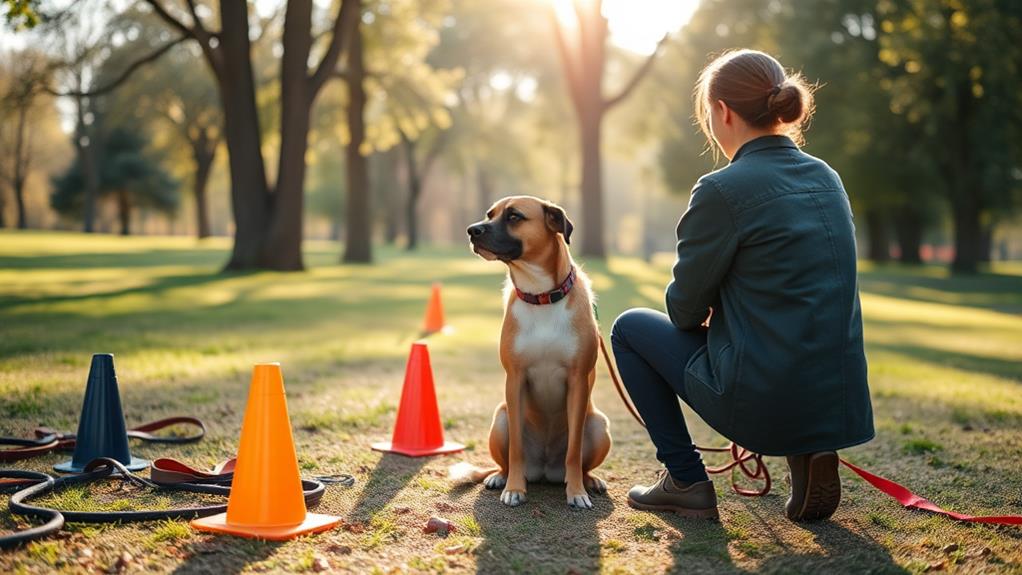You can master canine obedience using seven proven techniques that make training effective and enjoyable. Start by establishing clear, consistent commands, and use positive reinforcement to reward good behavior. Incorporate regular training sessions, socializing your dog with various environments and people. Keep the training fun with interactive games and celebrate small victories. Be patient and persistent, understanding that dogs learn at their own pace. Gradually increase distractions to help your dog focus in busier settings. With these techniques, you'll create a strong foundation for obedience, and there's even more to discover to refine your skills further.
Establish Clear Commands
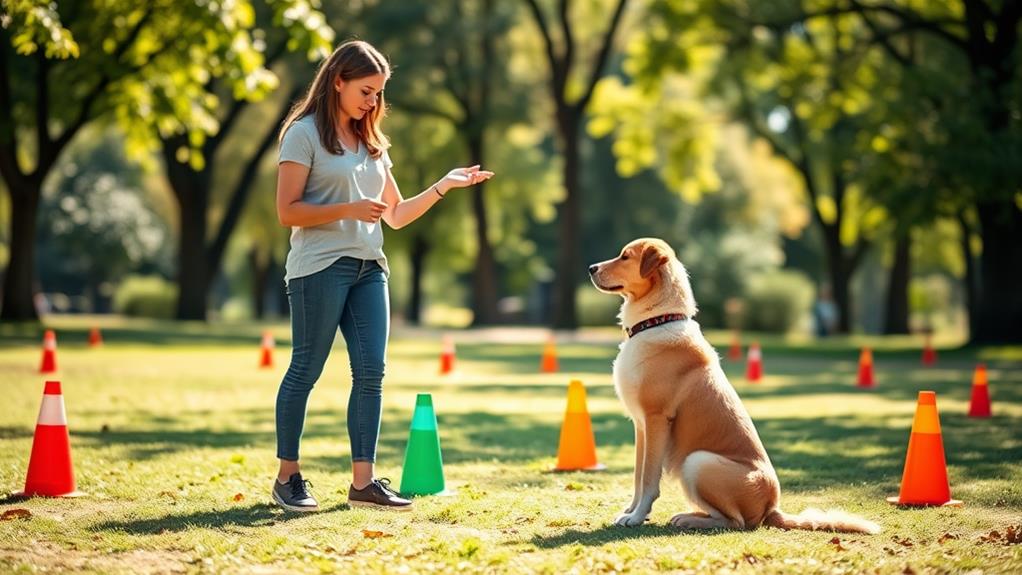
Establishing clear commands is essential for effective canine obedience training. When you communicate precisely with your dog, you eliminate confusion and help them understand what you expect.
Start by choosing simple, one-word commands like "sit," "stay," or "come." Consistency is key; use the same word every time so your dog associates it with the action you want.
Make sure your tone is firm yet friendly. Dogs respond better to commands delivered with confidence, so project authority without being harsh. It's also pivotal to use body language that matches your commands. For instance, extend your hand palm up when asking your dog to "stay."
Avoid using similar-sounding words for different commands to prevent mix-ups. For example, "down" and "stay" can easily confuse your dog if they're too close in sound.
Practice in short, focused sessions to keep your dog engaged and prevent frustration. Repetition reinforces learning, so don't hesitate to repeat commands until your dog gets it right. With clear commands, you'll pave the way for a well-behaved furry companion who understands exactly what you want.
Use Positive Reinforcement
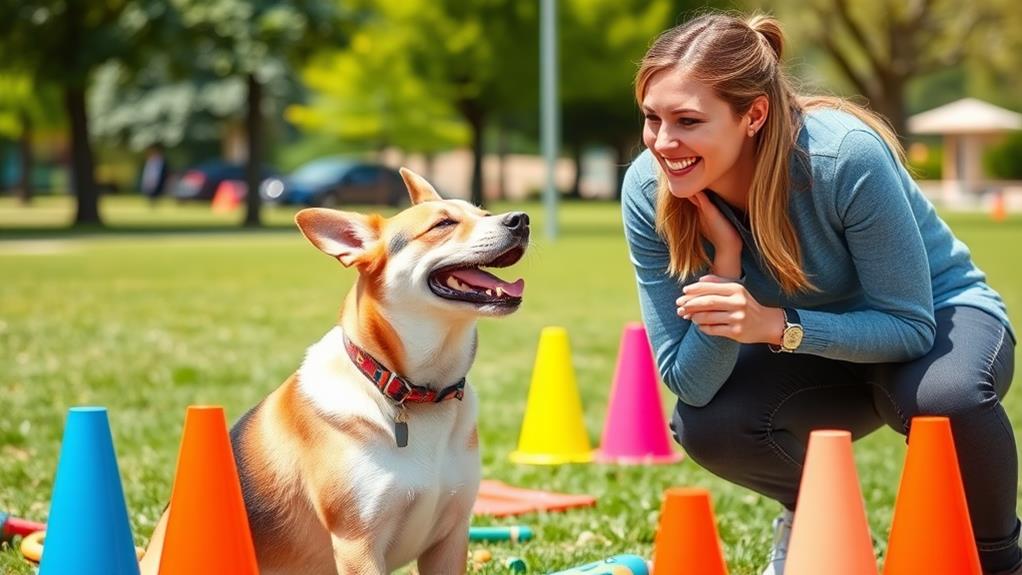
Using positive reinforcement is one of the most effective ways to train your dog while building a strong bond. This method involves rewarding your pup for good behavior, which encourages them to repeat those actions. Rewards can be treats, praise, toys, or even a quick play session—whatever your dog values most.
When your dog successfully follows a command, immediately offer a reward. This timing helps them connect the behavior with the positive outcome. For example, if you ask your dog to sit and they do, say "good sit!" while giving them a treat. This reinforces the action and makes it more likely they'll respond correctly in the future.
Consistency is key here. Make sure everyone in your household uses the same commands and rewards. This clarity helps your dog understand what's expected of them. Also, be patient; some dogs take longer to learn than others. If your dog isn't responding, consider adjusting your rewards or the way you're presenting commands.
Incorporate Consistent Training Sessions
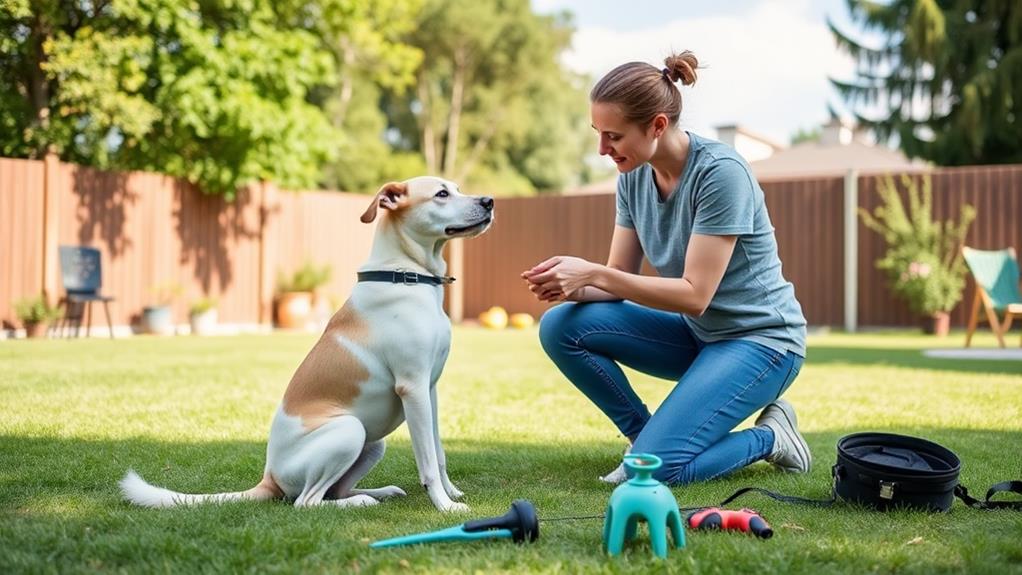
Regular training sessions are essential for reinforcing your dog's learning and ensuring lasting obedience. By committing to a consistent schedule, you create a structured environment that helps your dog understand what's expected. Aim for short, focused sessions—about 10 to 15 minutes—several times a week. This keeps your dog engaged without overwhelming them.
Consistency is key. Use the same commands and cues each time, so your dog can easily connect the dots. Be patient and persistent; it might take time for your dog to grasp new commands. If you notice your dog struggling, go back to basics and reinforce previously learned skills.
Mix up the training exercises to keep things interesting. Incorporate a variety of commands, such as sit, stay, and come, while gradually introducing new skills. This variety not only keeps your dog's attention but also helps build their confidence.
Don't forget to celebrate your dog's progress! Use positive reinforcement techniques to reward good behavior during training sessions. This fosters a sense of accomplishment and encourages your dog to learn more. With consistent practice, you'll see improvements in your dog's obedience and responsiveness.
Socialize Your Dog
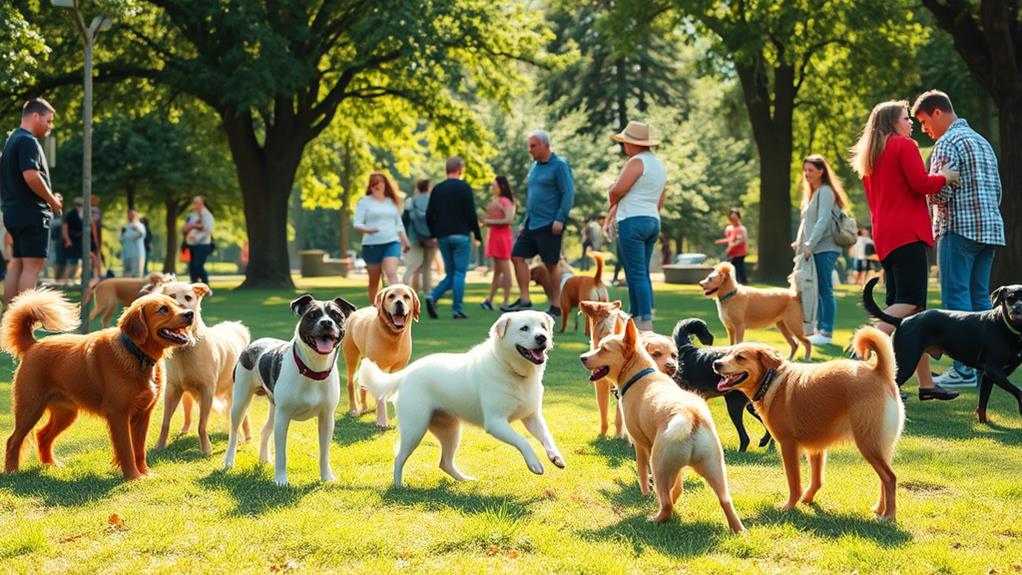
Socializing your dog is just as important as consistent training sessions. When your furry friend interacts with various people and other dogs, it helps them develop good behavior and confidence. A well-socialized dog is less likely to exhibit fear or aggression, making outings enjoyable for both of you.
Exposure to Different Environments: Take your dog to parks, busy streets, or pet-friendly shops. New sights, sounds, and smells will help them adapt and feel comfortable in diverse settings.
Positive Interactions: Arrange playdates with friendly dogs and invite visitors over. Ensure these encounters are positive, offering treats and praise to create a happy association with new experiences.
Gradual Introduction: Slowly introduce your dog to new situations. Start with controlled environments and gradually increase the level of exposure. This helps prevent overwhelming them and allows for a smooth progression.
Keep Training Fun
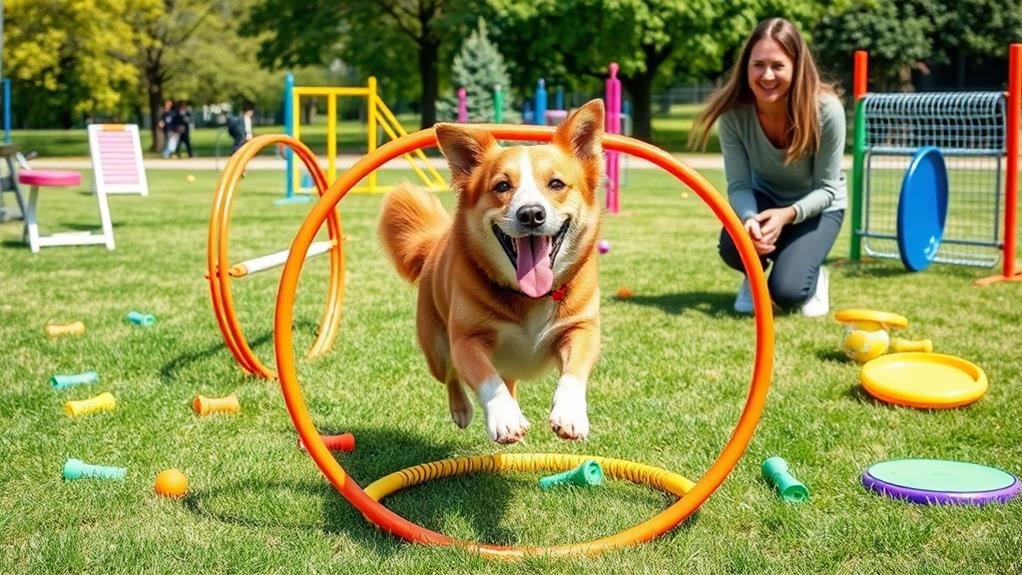
Keeping training fun is essential for maintaining your dog's enthusiasm and zeal to learn. When you incorporate play into your sessions, your dog looks forward to training instead of seeing it as a chore. Use games, toys, and positive reinforcement to create an engaging environment.
| Activity Type | Benefits |
|---|---|
| Interactive Games | Enhances bonding and keeps your dog active. |
| Reward-Based Training | Motivates your dog to learn new commands with treats or praise. |
| Short Sessions | Prevents boredom and keeps your dog focused. |
| Varied Activities | Stimulates your dog's mind, preventing routine fatigue. |
Mix it up! Try different locations, new tricks, or even some agility exercises. This variety can keep your dog excited and interested to participate. Remember, the more enjoyable the training, the more likely your dog will retain what they learn. Celebrate small victories with praise or a fun play session. By keeping things light and fun, you'll foster a positive learning atmosphere that benefits both you and your canine companion!
Practice Patience and Persistence

Training a dog isn't always a smooth ride; it often requires you to buckle down and commit to patience and persistence. You may encounter challenges along the way, but remember that every small victory counts. Your dog will pick up commands at their own pace, and it's essential to stay the course.
Set Realistic Goals: Break down training into manageable steps. Instead of expecting your dog to master a command in one session, aim for gradual progress. Celebrate those little milestones!
Stay Consistent: Use the same commands and cues each time. Consistency helps your dog understand what you expect, making it easier for them to learn.
Keep a Positive Attitude: Your dog can sense your emotions. If you're frustrated, they may become anxious or lose interest. Maintain a calm demeanor and encourage them with praise, even when things don't go as planned.
Gradually Increase Distractions
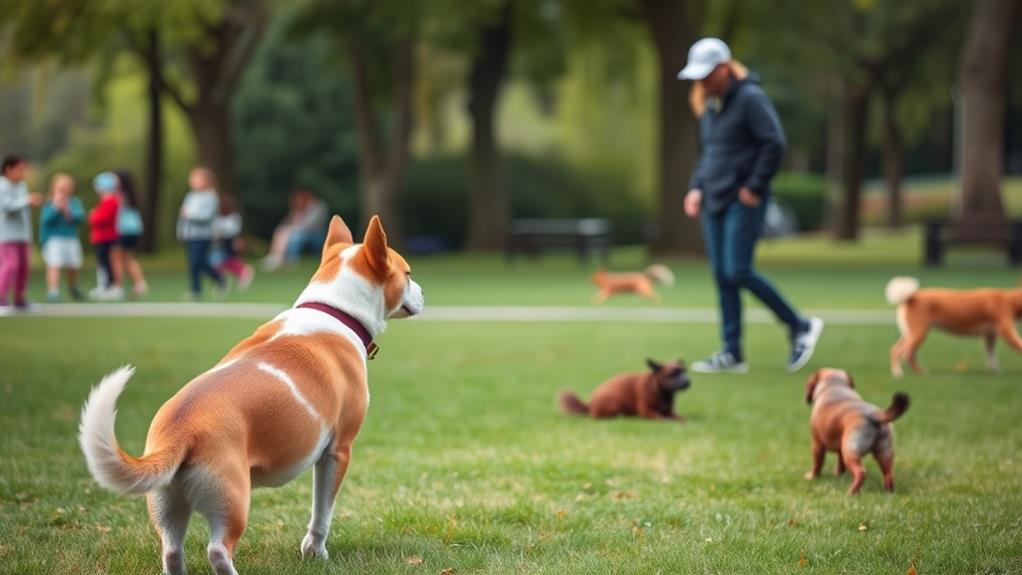
Distractions can be a formidable challenge during dog training, but introducing them gradually can enhance your dog's focus and obedience. Start in a controlled environment, like your living room or backyard, where there are minimal distractions. Begin with basic commands like sit or stay, ensuring your dog understands the task at hand.
Once your dog is comfortable with these commands, gradually introduce mild distractions. This could be a friend walking by or a toy nearby. Keep the training sessions short and positive. If your dog loses focus, gently redirect them back to the task without scolding.
As your dog masters commands amid these distractions, slowly increase the difficulty. Move to a park or an area with more activity. Here, you can introduce sounds, people, and other dogs. Always reward your dog for staying focused and responding to commands, even in a busier environment.
This gradual approach helps build your dog's confidence and reinforces their training. Remember, consistency is key. With time and patience, your dog will learn to remain obedient, even when distractions are present.
Frequently Asked Questions
What Age Should I Start Training My Dog?
You should start training your dog as early as eight weeks old. Puppies are enthusiastic to learn and adapt quickly. Consistent training helps build a strong bond and encourages good behavior throughout their life.
How Long Should Each Training Session Last?
Each training session should last about 5 to 15 minutes, depending on your dog's age and attention span. You'll keep sessions short and engaging, ensuring your pup stays focused and enthusiastic to learn.
Can I Train Multiple Dogs at Once?
Training multiple dogs at once can feel like herding cats! You can do it, but keep sessions short and engaging. Focus on each dog individually, rewarding good behavior to maintain their attention and prevent chaos.
What Common Mistakes Should I Avoid During Training?
During training, avoid inconsistency in commands, neglecting rewards, and overlooking distractions. Don't rush the process; patience is key. Keep sessions short and engaging to maintain your dog's interest and reinforce positive behavior effectively.
How Can I Tell if My Dog Is Bored With Training?
If your dog's eyes glaze over like a donut, it's a sure sign boredom's creeping in! Watch for distracted behavior, lack of engagement, or repeated yawns. Keep training exciting to reignite their enthusiasm!
Conclusion
By mastering these seven proven techniques, you'll transform your dog into a well-behaved companion, ready to showcase their skills in any setting. Picture your dog sitting calmly at your feet in a bustling park, drawing admiring glances from passersby as they respond to your every command. With dedication and love, you'll forge an unbreakable bond, filled with joy and shared adventures. So grab those treats, step outside, and watch your canine companion thrive in obedience and happiness!

